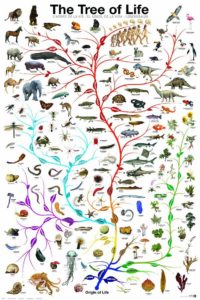In this second post of our Ask Chloe series, I talk about some interspecies relationships dolphins have with sharks and humans. But before that, I take a trip back to about 420 million years ago.
Shana B: How closely related are dolphins and sharks?
Allyn T: What are dolphins evolved from? Also, what did they evolve to make use of in the environment and ecosystem?
Dolphins are about as related to sharks as humans are, in the sense that all life began in the ocean. Bony fish used to roam the seas, until about 420 million years ago, when cartilaginous fish (such as sharks and rays) evolved into a new class. Around 395 million years ago, the first vertebrates ventured onto land. Some of these vertebrates eventually found their way back into the sea until finally the genus to which bottlenose dolphins belong, Tursiops, emerged 5 million years ago.
Dolphins come from the same evolutionary line as giraffes, hippopotamuses, horses, camels, and bison. Today their closest terrestrial relatives are cows! Cetaceans (aquatic mammals including dolphins, whales, and porpoises) evolved from land-dwelling mammals that lived between 65 and 95 million years ago. The Pakicetus is the animal considered to be the ancestor of the cetacean line. These hairy land animals did most of their hunting for food in the ocean. Slowly the Pakicetus spent more and more of its time in the ocean, until all of its time was spent in the ocean. Their bodies evolved in response to the different environmental demands of an aquatic life. Their nostrils moved to the top of their heads for easier breathing at the water’s surface. Hair was no longer necessary for staying warm underwater, and hairless skin became more hydrodynamic. In order to stay warm, cetaceans developed a layer of blubber which provides insulation. Echolocation was first found in Squalodon, the first toothed whale, 30 million years ago. Echolocation is useful underwater because sound travels faster underwater and vision is not the most accurate mechanism for getting a spatial sense of one’s environment underwater. The modern form of echolocation developed around 20 million years ago. Cetaceans also evolved to be conscious breathers, meaning that unlike humans, they must control when they breathe. Since they have to remember to breathe, dolphins also evolved to sleep with only half of their brain at a time, which gave them the added benefit of constant vigilance against predators.
To recap, sharks came on the scene about 419,800,000 years before humans did. Bottlenose dolphins came along approximately 395 million years after the first sharks (about 5 million years ago). And modern humans only came on the along around 100 thousand years ago!
Shana B: Do they (dolphins and sharks) ever interact with each other? is there a record of friendship between the two?
Sharks are a dolphin’s primary predator, aside from humans. Along with dealing with full attacks by larger sharks, dolphins also have to put up with attacks from a smaller shark species. Cookie-cutter sharks frequently take bite-size chunks out of dolphin flesh, leaving their victims to swim along with an open wound. But dolphins and sharks are incapable of peacefully coexisting. There are many species of sharks, and not all are as dangerous as Tiger sharks or Great Whites. At Rangiroa Atoll, dolphins coexist with various species of reef sharks. In fact, when dolphins work together, they can have a pretty aggressive and successful defense against sharks. Which leads me to the next question!
Ben D (NYC director, cinematographer, choreographer, 3D specialist): How can Dolphin empathy for humans be measured?
Empathy can be a hard thing to define and measure in any species, even in humans! But there is some reason to believe that dolphins are capable of understanding when a human is in danger and making the choice to help. Dolphins have found their might in numbers, and are great at teaming up with each other to chase off pesky sharks. And sometimes, they even chase sharks away from humans. This video is by conservation filmmaker Hardy Jones, who is an advisor to Dolphin Dance Project.
There are numerous other stories of dolphins saving humans from drowning or otherwise helping people in danger.
For Further Thought…
It’s impossible to overemphasize the complexity of each of these interspecies relationships. To make a generalized blanket statement about dolphins having good or peaceful relationships with one species, and a bad or aggressive relationship with another species, would be to oversimplify the workings of the natural world. Equally puzzling is the question of how to define dolphin-human relationships. Most of us don’t eat dolphins, yet we are still responsible for too many dolphin deaths. Sometimes we harm dolphins in ways of which we aren’t even aware, such as the tuna or plastic we use. Our world is interconnected, which often means that the ways we affect the ocean and its inhabitants and the ways they affect us can be more complicated than what appears on the water’s surface.
Sometimes things are not what they seem, and our assumptions about how animals work can lead us astray. Human-shark encounters have a notoriously bad reputation, and usually we categorize the sharks as the villains. But relationships are complicated, and a lot of the time, sharks can play nice. This video is from my previous internship with I Am Water Ocean Conservation. It shows me peacefully swimming with blacktip reef sharks in Mozambique, South Africa.


